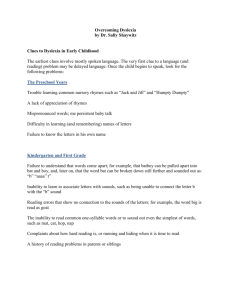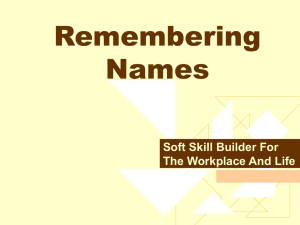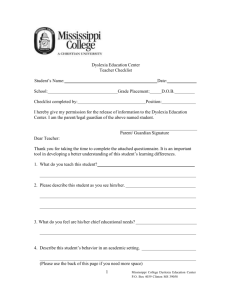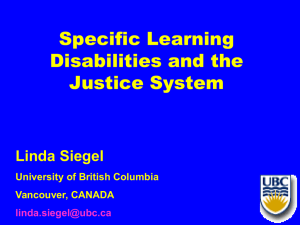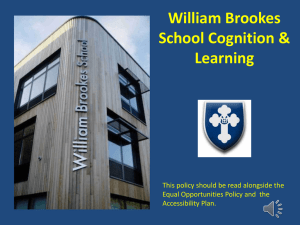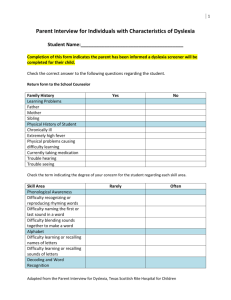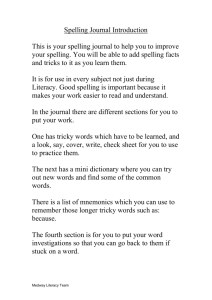Providing Dyslexia Tutor Support to Students
advertisement
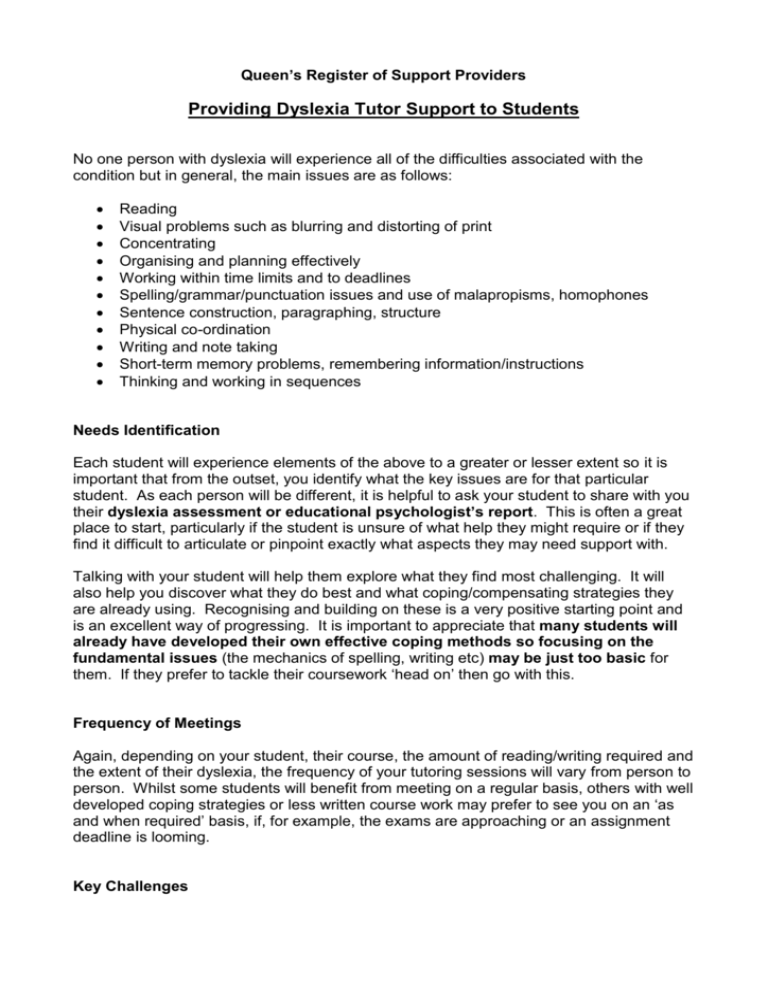
Queen’s Register of Support Providers Providing Dyslexia Tutor Support to Students No one person with dyslexia will experience all of the difficulties associated with the condition but in general, the main issues are as follows: Reading Visual problems such as blurring and distorting of print Concentrating Organising and planning effectively Working within time limits and to deadlines Spelling/grammar/punctuation issues and use of malapropisms, homophones Sentence construction, paragraphing, structure Physical co-ordination Writing and note taking Short-term memory problems, remembering information/instructions Thinking and working in sequences Needs Identification Each student will experience elements of the above to a greater or lesser extent so it is important that from the outset, you identify what the key issues are for that particular student. As each person will be different, it is helpful to ask your student to share with you their dyslexia assessment or educational psychologist’s report. This is often a great place to start, particularly if the student is unsure of what help they might require or if they find it difficult to articulate or pinpoint exactly what aspects they may need support with. Talking with your student will help them explore what they find most challenging. It will also help you discover what they do best and what coping/compensating strategies they are already using. Recognising and building on these is a very positive starting point and is an excellent way of progressing. It is important to appreciate that many students will already have developed their own effective coping methods so focusing on the fundamental issues (the mechanics of spelling, writing etc) may be just too basic for them. If they prefer to tackle their coursework ‘head on’ then go with this. Frequency of Meetings Again, depending on your student, their course, the amount of reading/writing required and the extent of their dyslexia, the frequency of your tutoring sessions will vary from person to person. Whilst some students will benefit from meeting on a regular basis, others with well developed coping strategies or less written course work may prefer to see you on an ‘as and when required’ basis, if, for example, the exams are approaching or an assignment deadline is looming. Key Challenges Below is a list of the key issues faced by dyslexic students, together with some strategies that you might try with them. The table is by no means exhaustive or very detailed. It is intended as a guide only as each of your students will have different needs, priorities and course requirements. Key Issues and Problems Learning and Thinking Style: Thinking style – holistic or analytic? Learning style - kinaesthetic (seeing, hearing, doing), tacticle (touching, smelling) or multisensory? Organising study time: ‘Finding’ study time between friends, family, work commitments and classes Double the workload - having to read/reread material and understand new concepts/vocabulary Suggested Strategies Memory techniques/mnemonics - identify how the student thinks/learns most easily ie their preferred learning style(s) and build on this: Mind maps / concept maps Lists eg ‘To do’ Spider diagrams Flow charts Note cards Visual/shape memory pegs Rooms and items around the house Reading aloud Mnemonic phrases/poems Auditory memory/rhyme pegs Rhymes Acronyms Tune association Recording and listening back to information Reading: Visual discomfort Slower pace Comprehension difficulties Distortion of print Glare from white pages Words appearing to move, jumble or blur ie scotopic sensitivity (mears- Identifying an appropriate study space Organising materials/equipment Diary use Class timetables Colour coding for different modules Semester schedules/planners with key deadlines for assignments Wall charts Study timetables/charts that divide a week into days and hours to identify work, travel, study time and time off. Suggest: Enlarging the size of the print Changing the font style Using coloured acetate overlays Reading material out aloud Recording and playing it back Making note cards of key words/concepts, definitions, new irlen syndrome) Spelling: Spelling errors Transposing of letters Malapropisms - difficulties distinguishing between similar sounding words with different meanings/spellings Homophones and incorrect usage Writing/composing: Slow writing speeds Poor note taking skills Lack of clarity Slow copying Losing the ‘flow’ Confusing composition and transcription Muddled ideas Disjointed material Poor sequencing of information/ideas words etc Speed reading development Smarter reading skills Proof reading skills development to spot own errors Note cards of the spellings of new/unfamiliar words and their definitions Revision of spelling rules Mneumonics Repetition/chanting Using of pictures/visualization techniques to help imprint spellings in the mind Post-its of regularly used words around the house Dictionary/thesaurus use Alphabet arc to help with looking up words in dictionary/thesaurus Effective use of assistive technology – TextHelp Read & Write Gold, spellchecker, scanner pen, Dragon Develop note taking skills Try different types of pen (eg ballpoint vs fibre tips) Different coloured inks Optimal paper colour Using a PC/laptop/word processor instead of handwriting Distinguish between composition and transcription Unpacking the question- question analysis/decoding Essay planning Structuring and paragraphing Chunking Using mind maps, spider diagrams etc to organize thoughts and ideas Effective use of assistive technology such as Inspiration and Mindview for same Develop proof reading techniques to spot grammatical/structural errors Using quotes Report writing Referencing Exam Preparation: Poor preparation Ineffective revision techniques Poor organizational abilities Exam-related anxiety Bibliographies Plagiarism Using lecturer/tutor assignment feedback Identifying the preferred learning style (and therefore the most effective memory techniques) Identifying an appropriate study location Organisation of notes/course materials Developing a flexible revision schedule of optimal study periods, breaks, review sessions etc against topics to be covered Condensing notes Using topics/headings Chunking Being selective Using different colours/highlights Revision posters Revision cards Brainstorming techniques – diagrams, charts, mindmaps etc Listening to information – use of assistive technology to review/revise material aurally Mnemonics Past exam paper review Practice session(s) with Reader/Exam Scribe (if applicable) Role play (for practical exams) Self-testing Question analysis/decoding – identifying what the question is asking the candidate to do (process words, question topic, question focus and inclusion of examples) Planning strategies – how much time to spend on question preparation and answering per question/section Relaxation, stress and anxiety management techniques Maths: Decoding numbers, letters and symbols more slowly Decoding errors Understanding and remembering the Mnemonics Saying it aloud/using fingers (visual and auditory) Chunking digits/formulae language of maths Remembering equations Applying equations/formulae correctly Remembering the correct order of operations Foreign Languages: New vocabulary/rules New/unfamiliar words Pronunciation difficulties Differently structured language Different language ‘rules’ Music: Different language Different symbols/shapes Same shapes in different locations mean different things ‘Reading’ must be co-ordinated with particular hand/mouth movements Linking with a familiar tunes/rhythms Fostering remembering by understanding – understanding the meaning of formulae/equations helps with both accurate remembering and usage Translating formulae into words Acronyms Making note cards of key formulae/words Using the multiplication square – pattern recognition of multiplications from 1 to 12 Using the fast finger method for multiplying numbers from 6 to 10 Mnemonics Multisensory learning Use of colour Use of pictures to link words/phrases to images Visual/shape memory pegs Repetition Auditory memory/rhyme pegs Rote learning of exact phrases/sentences Note cards of key words/phrases Colour overlays to counter visual distortions Mnemonics Using linkwords associated visually or audially with the target word Mental images, associations and phrases Writing names of notes on the keyboard Note cards of key symbols Zoom-Ex Machine Located in the McClay Library, the Zoom-Ex machine is a digital scanner/OCR that converts any printed text into multiple formats such as speech, large print, sound files and text files etc. As such, it is useful facility for those dyslexic students who find it easier to understand the spoken word or are better able to read text in larger fonts. If, as a Tutor, you would like to become familiar with the Zoom-Ex scanner to give more informed advice/guidance to your students, training courses are periodically arranged by the Register. The scanner may also be borrowed for short periods by contacting Sally Bridge, the Library’s Information Services Disability Co-ordinator on s.bridge@qub.ac.uk, 90 976145. Recommended Reading Hargreaves, Sandra Study Skills for Students with Dyslexia Sage (2012)


